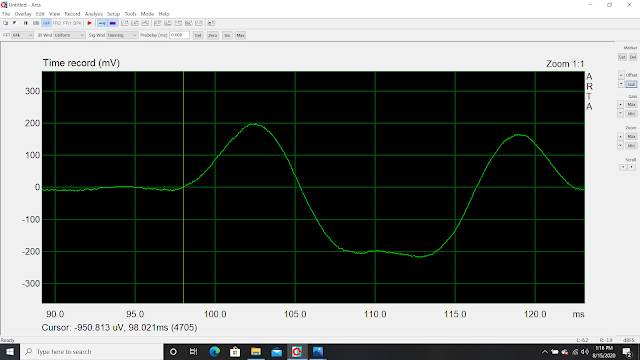I've previously observed phenomena I've labeled phase lead. The response of all speakers I've measured, except for supertweeters (which have different phenomena), is marked by a leading negative phase portion in response to a square transient pulse.
This leading negative phase portion seems to last about 4ms for both my subwoofer and my panels under some conditions. Sometimes I remembered or mis-remembered seeing much less from the panels, but the latest set of measurements in the previous post shows the phase lead portion uniformly at around 4ms.
I started by looking at the drive signal to the subwoofers, which I captured from the analog outputs of my Behringer 2496 EQ. My system actually uses the digital outputs, which are routed to an Emotive Stealth DC-1. For the purposes of an initial test, I decided the analog outputs of the Behringer (different DAC chip and circuitry) were close enough. (I tried to connect to the unused single ended outputs of the Emotiva, but it was clear I could not do that without disconnecting a bunch of other things to get at it. So I chose an easier test, which might use some revisiting later.)
 |
| Electrical signal to left Subwoofer |
Notice how the electrical version of the transient pulse sort of looks like a transient pulse with a flat top, but very sloped instead of square sides. But it doesn't take too much careful examination to see the negative phase lead, from about 78.5 to 82.5 ms. (These do not include the final acoustical delay and others, so they are about 20ms less than the microphone measurements posted before.)
One troubling thing, however is the low amplitude of the phase lead relative to the transient top. It appears to have at most 1/10th the amplitude. I thought I remembered seeing far more than that. Let's take a look at the left subwoofer transient measurement a few days earlier.
 |
| Left Subwoofer Output at Listening Position |
Well, maybe not. Here again the phase lead of about 4ms total duration appears to have about 1/10 or less of the magnitude of the bass peak.
I next decided to look at the output of the midrange DEQ in response to the transient.
 |
| Midrange electrical signal |
Once again, we see about a 4ms phase lead, which in this case might be preceded by another 4ms positive phase phase lead lead.
Hoping for less confusion, I turned off the minimal EQ I apply in the midrange DEQ itself, so as to see only the effect of the linear phase LR8 crossover in the miniDSP unit preceding the DEQ:
Not any obvious differences. I then tried bypassing the linear phase crossovers.
Now this has really changed things. I'm shocked how fast the top of the transient collapses. Did I somehow not bypass the highpass filter (bass crossover)? But with regards to the phase lead, it has radically changed. Now it lasts 0.2ms instead of 4ms. But, and very strangely, the magnitude looks even larger than 10%, maybe as much as 20%.
To bypass the EQ chain entirely, including the crossovers in the miniDSP's, I then looked at the analog output of my Tact digital preamplifier. I do not use this output, I use the AES digital output which feeds all my EQ processors. However, it's a very high quality analog balanced output, suitable for a $5k premap in 2000, which should mirror the unprocessed digital output signal about as close as can be done.
The short duration phase lead as we saw with crossovers bypassed is still there! What about the output of the Focusrite 2i4 itself? I did a loopback using an unbalanced cable with a 1/4 phone plug into the input of the Focusrite and got this:
Well, darned if it doesn't also have the short phase lead I started to see after bypassing the crossovers.
The current conclusion is:
1) I see the phase lead in everything, including the Focusrite interface itself.
2) The phase lead after crossovers are applied get much longer in duration, from about 0.2ms to 4ms.
This may be phenomena which are found in everything to a greater or lesser degree, as with high frequency rolloff. But the crossovers I'm using now make this much longer in duration, if slightly smaller in magnitude. And I believe I've seen the issue with other crossovers also.
3) Since the phase lead from crossover appears identical for highpass and lowpass parts, it's OK either to align uniformly to the beginning of the phase lead, OR the beginning of the primary positive rise. The latter is easier to read, AND gets past the possibility of phase lead lead which I've seen in some cases.




No comments:
Post a Comment